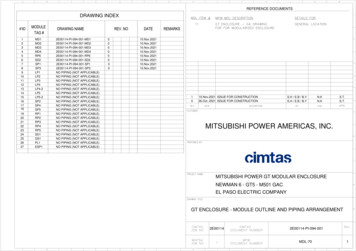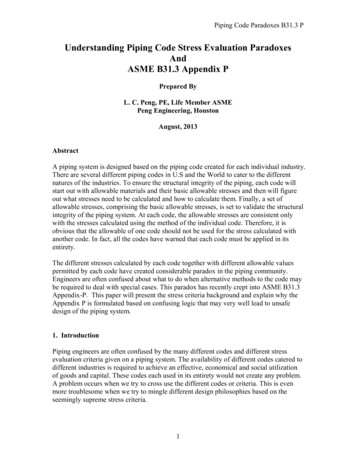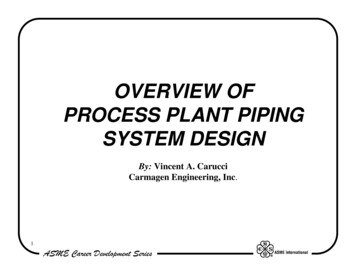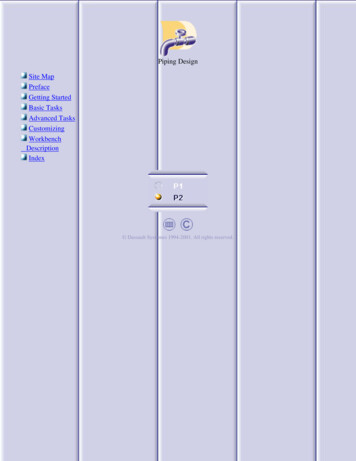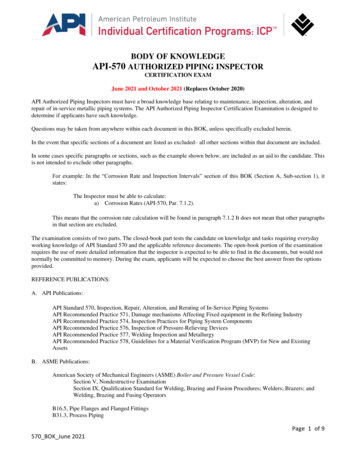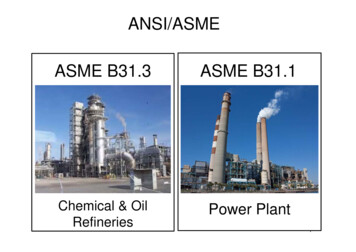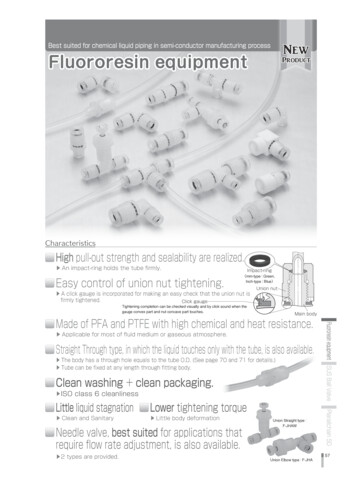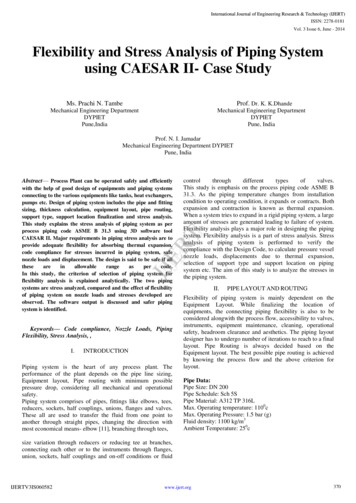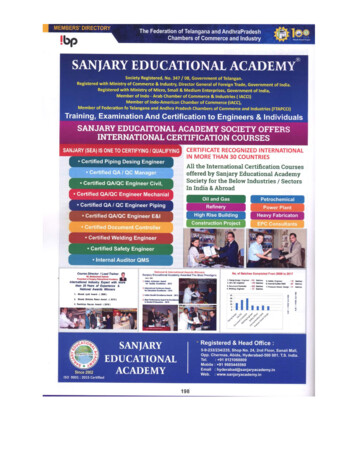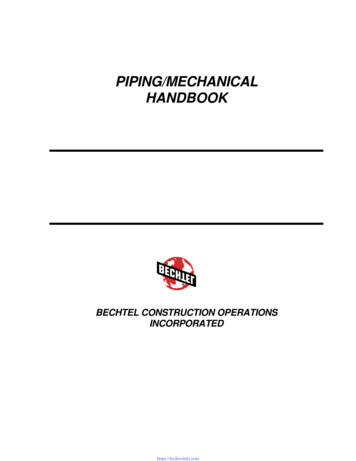
Transcription
PIPING/MECHANICALHANDBOOKBECHTEL CONSTRUCTION OPERATIONSINCORPORATEDhttps://boilersinfo.com
Second Edition. Bechtel Corporation 1997. All rights reserved.Contains confidential information proprietary to Bechtelnot to be disclosed to third parties without Bechtel's priorwritten permission.Printed in the United States of America.https://boilersinfo.com
ForwardThis handbook is not under controlled distribution. Rather, it is intended for use as a training textin conjunction with detailed training provided by subject matter experts. The handbook has beendeveloped to assist in the training and development of Bechtel Piping and Mechanical FieldEngineers and Superintendents and is part of Bechtel's overall technical training program. Thehandbook is also intended to provide useful guidelines, information, and data to assist fieldpersonnel in making day-to-day decisions. All reference materials included in this handbook arefor illustration purposes only and shall not be used for actual work execution.The handbook is not intended to replace codes, standards, procedures, or engineeringspecifications. The handbook does, however, provide a ready reference guide that may be usedin conjunction with the project requirements. 1996 Bechtel Corp.Piping/Mechanical Handbookhttps://boilersinfo.comFRWD-1
Table of ContentsPiping/Mechanical HandbookTABLE OF CONTENTSSECTION 1CORPORATE PIPING/MECHANICAL PROCEDURESSECTION 2SAFETYSECTION 3DUTIES AND RESPONSIBILITIESSECTION 4PIPING/MECHANICAL DESIGN DRAWINGSSECTION 5PIPE SIZES AND MATERIALSSECTION 6PIPE JOINTS AND BENDINGSECTION 7VALVESSECTION 8STRAINERS AND TRAPSSECTION 9FIELD PIPING GUIDELINESSECTION 10UNDERGROUND AND EMBEDDED PIPING SYSTEMSSECTION 11INSULATION AND HEAT TRACINGSECTION 12HANGERS AND SUPPORTSSECTION 13CLEANING AND FLUSHING METHODSSECTION 14LEAK TESTINGSECTION 15MECHANICAL EQUIPMENTSECTION 16PUMPSSECTION 17AIR COMPRESSOR SYSTEMSSECTION 18HEAT EXCHANGERSSECTION 19HVAC SYSTEMSSECTION 20CHILLER SYSTEMSSECTION 21FANS AND BLOWERSSECTION 22CONVEYOR SYSTEMSSECTION 23CRUSHERS AND PULVERIZERSSECTION 24BEARINGS AND LUBRICATIONSECTION 25GLOSSARYSECTION 26REFERENCES 1996 Bechtel Corp.Piping/Mechanical Handbookhttps://boilersinfo.comTOC-1
Section 1Corporate Piping/Mechanical ProceduresGeneralPiping and Mechanical components form the heart of almost all industrial construction projects.Whether the project is for a Mining and Metals, Petroleum, Chemical, Power, or Defenseapplication, the mechanical system requirements have many common features.Due to the diversity of markets that Bechtel serves, however, it is not possible to develop a singlecorporate procedure applicable to the installation of piping and mechanical systems for all Bechtelprojects. As a result, Bechtel corporate procedures require that each construction project developspecific installation procedures or guidelines that are appropriate for the project. Theseprocedures must address specific customer requirements and local regulations. The project mustalso provide: Craft trainingPeriodic inspection of tools and equipmentPreplanning of work operationsMonitoring and inspection of completed workTo assist construction projects in the development of project specific procedures, GenericConstruction Project Procedures have been developed. These procedures provide a startingpoint for the development of the project procedures and normally are based on proceduresdeveloped at other construction projects.The following corporate instruction requirements are applicable:SITE MANAGERS MANUALSite Managers Manual Instruction S4.4, Field Engineering, defines the general responsibilities ofthe Field Engineering as part of the project construction team. Instruction S4.5, Quality ControlProgram, defines the project requirements to develop and implement a construction qualitycontrol program on the project.FIELD ENGINEERING MANUALThe Field Engineering Manual contains several instructions that are applicable to Piping andMechanical work on projects. These include:Instruction F2.4, Project Procedure Development, provides requirements for the development ofproject specific proceduresInstruction F3.1, Project Quality Control Plan, provides requirements for the development of aproject specific quality control plan.Instruction F3.2, Project Constructability Program, provides requirements for implementing aconstructability program on the project.Instruction F4.3, Construction Rigging Plans, establishes specific requirements for the preparationof rigging plans for Bechtel construction sites. 1996 Bechtel Corp.Piping/Mechanical Handbookhttps://boilersinfo.com1-1
Section 1Corporate Piping/Mechanical ProceduresInstruction F4.5, Welding Control, provides requirements for developing and implementingwelding controls on the project.Instruction F4.6, Standard Engineering Deliverables, summarizes agreements between theBechtel corporate Construction and Engineering Committees on standard engineering designdeliverables that will be provided for each project.Instruction F5.1, Quantity Reporting, summaries requirements for developing a project quantityreporting plan.GENERIC CONSTRUCTION PROJECT PROCEDURESThe following generic procedures related to the control of Piping and Mechanical work activitiesare typical of the types of Generic Construction Project Procedures that are available:03501-1, Underground Piping Installation03502-1, Above Ground Piping Installation03502-2, Field Fabrication of Pipe Spools03505-1, Pressure Testing of Piping03507-1, Insulation Installation03602-1, Rotating Equipment03603-1, Column, Vessel, Tank, and Exchanger Installation03606-1, Boilers and Fired HeatersAdditional generic procedures related to Piping and Mechanical work operations are available onthe On-Line Reference Library.CONSTRUCTION QUALITY MANUALInstruction Q3.5, Quality Verification, describes the corporate requirements for the implementationof a independent inspection program on construction projects.SAFETY PROCEDURESCorporate safety procedures and requirements are addressed in Section 2 of this handbook.1-2Piping/Mechanical Handbookhttps://boilersinfo.com1996:Rev.2
Section 2SafetyGENERALBechtel is committed to a ZERO INJURY safety philosophy in all of its construction work activities.The installation of piping components and mechanical equipment can result in serious accidentsand injuries if not properly planned and executed. As a consequence performing piping andmechanical installation work safely is one of the principle features of Bechtel's overall safetyprogram.OCCUPATIONAL SAFETY AND HEALTH ADMINISTRATION (OSHA) SAFETY REGULATIONSRequirements for safe construction rigging work practices in the United States are defined in theCode of Federal Regulations Title 29 Part 1926, Safety and Health Regulations for Construction.This document is organized into various "subparts" that each address a particular aspect ofconstruction work operations. The subparts applicable to piping and mechanical work operationsare discussed below:Subpart D - Occupational Health and Environmental ControlsThis subpart establishes requirements for noise, ventilation, illumination, and hazardous materialscontrols. Since many piping and mechanical work activities involve performing the work in tightquarters with high noise levels, a clear understanding of the provisions of this subpart isimportant.A hardhat, safety glasses, and hearing protection (e.g. ear plugs) should always be worn inthe work area.Subpart E - Personal Protective and Life Saving EquipmentThis subpart establishes minimum requirements for the use of fall protection devices includingsafety belts, lifelines, lanyards, and safety nets. The execution of piping and mechanical workoperations often requires individuals to work in elevated locations subject to falls and therequirements of this subpart are designed to prevent serious injuries that could result from a fall.Subpart G - Signs, Signals, and BarricadesThis subpart establishes minimum requirements for signaling and controlling traffic flows. Sincepiping and mechanical work operations often involve rigging and the movement of equipment andmaterials on roadways, the requirements of this subpart define the minimum signaling andbarricading requirements required.Subpart H - Materials Handling, Storage, Use, and DisposalThis subpart provides minimum requirements for the use of material handling equipment includingrope, slings, chains, shackles, and hooks. The requirements of this subpart are very specific andit is important that material handling capacities are clearly understood. 1996 Bechtel Corp.Piping/Mechanical Handbookhttps://boilersinfo.com2-1
Section 2SafetySubpart I - Tools - Hand and PowerThis subpart defines requirements for the handling and use of hand tools, power operated tools,abrasive wheels and tools, and jacks. All of these devices are used extensively in piping andmechanical work activities and requirements of the subsection must be understood.Subpart J - Welding and CuttingSince almost all piping and mechanical work operations involve welding and cutting operations,the requirements of this subpart are directly applicable to all work activities. Particular emphasisshould be placed on the requirements for fire prevention.Subpart K - ElectricalThis provisions for electrical lockout in this subpart are important for work that is performed in thevicinity of energized electrical systems.Subpart N - Cranes, Derricks, Hoists, Elevators, and ConveyorsThis subpart provides specific requirements for the control of heavy lift rigging equipment at theconstruction site. The subpart addresses requirements for rigging hand signals, rigging equipmentand hardware inspections, posting of crane load charts, and rigging work execution.Subpart T - DemolitionThis subpart defines safety regulations for the demolition of buildings and materials. Since manyretrofit work operations involve demolition activities, these regulations would be directlyapplicable.ROLE OF THE FIELD ENGINEER IN SAFETYThe Piping or Mechanical Field Engineer is a direct contributor to the safety of the workoperations at the construction site. Since all safe work operations must begin with preplanning,the Field Engineer makes a direct contribution to safety by reviewing the planned work with safetyin mind. The Field Engineer is typically responsible to develop a detailed work package for workplanned by the Superintendent, verify the required materials are available and obtain the requiredpermits to perform the work. The following specific types of questions might be asked by theField Engineer to ensure the work can be done safely: 2-2How will the materials get to the work location? Can preassembly be done to avoidperforming work in tight or cramped quarters?Does the work require the use of hazardous materials? Are MSDS sheets available at the sitefor all materials that are required to be used?Have all the required permits (e.g. confined space entry permits) been obtained to allow thework to be performed? Are there any special requirements that supervision or the craft needto be aware of prior to starting the work?Have all special equipment tagging requirements been satisfied?Are all the required materials available on the site? Have the materials been inspected fordamage or flaws that might cause injury during installation?Piping/Mechanical Handbookhttps://boilersinfo.com1996:Rev.2
Safety Section 2Has a thorough review for potential underground obstructions such as existing utilities,energized electrical cables and process lines been performed prior to authorizing the work toproceed?Is the proposed work site free of potential fire hazards? Is the housekeeping adequate?Are trenches or excavations adequately sloped or shored? Is a special shoring designrequired due to the depth or location of the excavation or trench?Have required rigging plans been prepared and approved? Have the requirements of theapproved rigging plan been reviewed with the craft who will perform the work?Is the scaffolding required to perform the work properly erected? Is a special scaffold designrequired to access the work location?1996:Rev.2Piping/Mechanical Handbookhttps://boilersinfo.com2-3
Section 3Duties and ResponsibilitiesGENERALExact duties and responsibilities of the Piping or Mechanical Field Engineer vary from project toproject depending on the scope of the work and the specific contractual requirements. A genericposition description for a Mechanical Field Engineer is shown in Attachment 3-1. A genericposition description for a Piping Field Engineer is shown in Attachment 3-2.QUALITYEnsuring the quality of the work done on a project is one of the major goals and objectives of theField Engineer. This goal is more than making sure that the craft are using the latest drawingrevision or that a system has been installed to project specifications. It must include monitoringhow the client perceives the progress toward project completion.To keep job quality at the highest level possible and maintain a positive client perception of thework that has been completed, the Field Engineer must ensure that: Project specifications and standards are metWork discrepancies are quickly identified and correctedQuality standards are maintained - do not compromiseTeamwork within the organization is developed and maintainedMaterials are properly controlledConstructability reviews are performed before work is released for constructionConstruction safety is considered in all work released to the craft for workProject quantities are properly reported and forecastMATERIAL CONTROLField Engineering material control duties will vary from project to project. A sample of materialcontrol duties may include: Preparing Field Material Requisitions (FMR)Preparing Material Receipt Instructions (MRI)Performing receiving inspection of material delivered to the construction siteVerifying that the proper paperwork has been received from the vendor with each orderDesignating proper material storage levelsWhen preparing requisitions and ordering material the Field Engineer must provide a completematerial description of each item needed. For example, when specifying 2 1/2 inch diameter A106grade B seamless carbon steel pipe, schedule 40, a key word in the material specification couldbe seamless. If the word seamless did not appear in the material requisition, the wrong materialcould be delivered to the site. 1996 Bechtel Corp.Piping/Mechanical Handbookhttps://boilersinfo.com3-1
Section 3Duties and ResponsibilitiesSuppliers and the Field Procurement buyer may not be aware of all project specifications and thejob could incur additional costs and schedule delays from restocking or replacing incorrectmaterial. Material stock codes which completely define particular materials should be usedwhenever possible to ensure the right material is purchased, received, and released forinstallation.Field material storage is normally handled by the Field Procurement group. The Field Engineer,however, should have a working knowledge of required storage levels including requirements fornitrogen blankets, and lay-up and should periodically check material laydown and warehouseareas for proper storage. The Field Engineer should also ensure that any required maintenanceis performed on equipment while in storage.CONSTRUCTABILITYConstructability, as defined by the Construction Industry Institute (CII), is "the optimum use ofconstruction knowledge and experience in planning, design, procurement, and field operations toachieve overall project objectives.”Constructability is an ongoing process of integrating construction knowledge and experience intoconceptual design, procurement, detailed engineering, and field construction operations whichprovides the opportunity to reduce project costs and improve project schedules.The ability to influence project costs and to incorporate construction experience and methods intoa project plan and design is greatest during the very earliest stages of a project. Therefore, thegreatest benefit of the constructability process will be derived with the earliest establishment andimplementation of a constructability plan on a project.Bechtel's Constructability Program provides construction input to the design process by takingideas and lessons learned on projects and applying them to present and future projects within thecompany. The Constructability Handbook describes the Bechtel Constructability Program in moredetail. The Field Engineer plays an important role in the successful implementation of theBechtel's Constructability Program.Bechtel’s corporate Lessons Learned and Best Practices are compiled and are available throughseveral ways: 3-2On-Line Reference Library (OLRL) contains lessons learned and best practices sectionswhich can be accessed by computer link to a regional office. This information is listed bygeneral subject title and can be retrieved at the construction site.Periodic construction newsletters and bulletins which provide information from other projectsand corporate initiatives.Periodic project meetings to review site progress and project lessons learned.The final Project Historical Report for completed projects which compile significant lessonslearned on the project.Piping/Mechanical Handbookhttps://boilersinfo.com1996:Rev.2
Duties and ResponsibilitiesSection 3The Field Engineer participates in the Constructability Program in several ways: Review project designs for constructability and suggest enhancements to improve theconstruction process on the project.Since the construction craft build what the engineer visualizes, solicit constructability ideasfrom the craft and craft supervision to take advantage of their knowledge of what can andcannot be built.Contribute to the corporate Lessons Learned Program to ensure that project field experienceis captured for use by future projects.LESSONS LEARNEDThe Field Engineer can make an important contribution to the organization by sharingexperiences and knowledge with the rest of the company. Proposed Lessons Learned aretypically recorded on a form similar to that shown in Attachment 3-3 and are submitted to sitemanagement for review and approval. Approved lessons are entered into the corporate On-LineReference Library (OLRL).Project Lessons Learned should be identified and submitted at all stages of the project and mustnot be used as a dumping ground for identifying problems. Do not submit a problem statement orexisting condition without offering a suggested solution or opportunity for improvement.SAFETYNew personnel on the site are typically given a general safety orientation covering the following: Specific job requirementsPotential hazardsGeneral refresher of safety practices expected from each workerThe Field Engineer plays a very important role in the administration of the safety program at theconstruction site. Some typical responsibilities include: Ensure that work is preplanned with safety in mindMonitor work areas for safety and housekeepingMaintain personal safety and set the exampleDevelop appropriate safety permits, clearances, and tagging requirementsMonitor subcontractor work for safe practicesEnsure Material Safety Data Sheets are available for the materials in use at the siteEnsure field design activities take worker safety into consideration1996:Rev.2Piping/Mechanical Handbookhttps://boilersinfo.com3-3
Section 3Duties and ResponsibilitiesCOST AND SCHEDULEProject Cost PerformanceWork performance at the job is tracked using the Jobhour Reporting System. A weekly costreport showing cost codes by each discipline is standard. The cost codes are tracked andevaluated to indicate how individual commodities are performing. An example is cost code P-11that follows 2-inch diameter and smaller carbon steel pipe. Pipefitters, Teamsters, and OperatingEngineers all charge to this cost code.Parallel to the labor charges, the Field Engineer prepares a periodic report showing acceptedquantities completed for the same time frame. The cost department then uses the quantitiesreported to calculate earned job-hours which is the product of the installed quantities and thebudget unit rate. The budget unit rate is the number of job-hours the project has been given toinstall a unit length of pipe (usually a foot or a meter).The actual job-hours charged are then divided by earned job-hours to calculate a cost codeperformance factor (PF). A PF of 1.0 or less indicates that materials are being installed at lessthan the budget for the project and is favorable. A PF greater than 1.0 indicates that budgets arebeing exceeded. In summary,EARNED JOB-HOURS (BUDGET UNIT RATE) X (QTY INSTALLED)PERFORMANCE FACTOR (ACTUAL JOB-HOURS) / (EARNED JOB-HOURS)Project SchedulesThe project plan or schedule is made up of several smaller plans. They include a 90/180 dayplan, near term schedules (1 to 4 weeks), and daily work schedules. The 90/180 day schedule isbased on a code account structure. Each activity will show the quantities to be installed and themanpower to be utilized for each period. Manpower will be summarized at the bottom and brokendown by craft. A summary of all 90/180 day schedules will yield total project manpowerrequirements by craft.The near term schedule describes in detail all the resources required and quantities of work to beaccomplished to achieve interim milestone dates. This level schedule is what the Field Engineernormally will use to plan material, work packages, and testing that will be required on the project.The schedule provides the definition of what will be needed on the project in the coming weeks.The basic guidance for project scheduling is to plan your work and work your plan.FIELD CRAFT SUPPORT/COMMUNICATIONIt is important that the Field Engineer develop the habit of checking with craft supervision eachmorning on what is being worked in assigned areas or on assigned systems. This will help plandaily work activities and allows for review of completed work for quality and progress reporting.One aspect of field support is to discuss with the craft the work ongoing. This develops goodopen communication and there will not be any "we vs. they" attitudes. Problems or questionsshould be reviewed early to prevent major reworks or confusion on how something wascompleted.3-4Piping/Mechanical Handbookhttps://boilersinfo.com1996:Rev.2
Another part of craft support is problem resolution. This may involve discussions with thesupervisor, Project Field Engineer, or Design Engineer to resolve and correct the condition. Itmay also require the generation of nonconformance reports, discrepancy reports, field changerequests, or field change notices to document the resolution of the problem.TYPICAL JOB ACTIVITY FLOWEarly Project Phase Review engineering drawingsMeet client representativesReview quantity tracking requirementsOrder field materialHelp in temporary site services layout and designDo underground pipingScope hydrostatic tests and system turnoversOrder testing equipmentReview schedules taking material and scoping needs into consideration and discuss anyconcerns with supervisionWork with supervision and project controls on erection sequences of large equipment andassist in developing rigging plans.Peak Construction Project Phase Receive and track materialProvide field support to superintendents and craftReview completed installations for correctness against drawingsPunchlist any discrepancies in completed workStart hydrostatic testing and releasing for insulationSet equipment as it arrivesLubricate stored material as needed and maintain lubrication recordsMaintain client interfaceContinue quantity reportingProject Completion Phase Develop punchlists and complete physical workTie-in equipmentComplete hydrostatic, flushing, and start-up testingComplete valve packing and flange torque checksComplete as-builtsTurnover systems to client 1996 Bechtel Corp.Piping/Mechanical Handbookhttps://boilersinfo.com3-5
Section 3 3-6Duties and ResponsibilitiesSurplus extra materialPiping/Mechanical Handbookhttps://boilersinfo.com1996:Rev.2
Duties and ResponsibilitiesSection 3SAMPLE MECHANICAL FIELD ENGINEER POSITION DESCRIPTIONATTACHMENT 3-1POSITION:MECHANICAL FIELD ENGINEERThe Mechanical Field Engineer is responsible to the Project Field Engineer for adherence tospecifications for all equipment installation work.DUTIES AND RESPONSIBILITIES: Provides technical assistance to the Mechanical or Equipment Superintendent, AreaSuperintendent and Area Engineer and keeps them informed on matters relating to qualitycontrol.Establishes with the client personnel, parameters on testing, installation and turnover ofsystems and major equipment.Determines area priorities for equipment installation through consultation with AreaSupervision.Establishes communications with Design to resolve field problems.Reviews the project schedule and working with the Mechanical or Equipment Superintendentand Area Engineer, develops the 90/180 day schedules as required.Performs inspection of all equipment installation work in progress on a continuing basis.Witnesses tests and completes final equipment checks and tests prior to client turnover.Assists the Mechanical Superintendent and Area Engineers in solving equipment problems.Implements inspections of equipment installations.Executes field takeoffs from design drawings and provides input to the quantity trackingsystem.Reports weekly installed quantities to the Cost Engineer.Writes material requisitions for all equipment testing equipment, spare parts, gaskets, andlubricants required for the job.Maintains an open dialogue with site and factory vendor representatives to assessrequirements and needs for having vendor representatives at the site.NOTE: Having vendor representatives at the site is normally required during the startup oflarge and/or complex product moving systems such as pumps, compressors, turbines,conveyors, boiler systems, and moving/feeding systems.Assists Area Engineers on equipment related problems to obtain vendor information,substitutions and other design related problems.Assists the Field Procurement Supervisor in the inspection and receipt of piping materials andin the setting up of site controls for storage, protection, and maintenance of permanent plantequipment and associated materials.Maintains as-built information for equipment installations.Determines the scope of any equipment installations not shown on the design drawings, suchas seal water piping.1996:Rev.2Piping/Mechanical Handbook3-7
Section 3 3-8Duties and ResponsibilitiesEstablishes with the design office, those permanent materials and construction materials to beordered by the field, establishes cut off dates for Regional Office material requisitioning andissues field material requisitions as required.Assists the Superintendent in establishing equipment delivery priority.Monitors off-site equipment fabrication through expediting to coordinate the proper priorityflow of equipment to the site. Also maintains updated delivery schedules from the fabricator.Determines the amount of equipment erection to be done in the field. Designs the fieldfabrication and assembly facilities for field pre-assembly work with a complete building layoutand material list. Coordinates efforts with craft supervision to determine the amount ofprefabrication work is to be performed and how much will be fabricated at the site prior to fielderection.Monitors code-designed systems to coordinate flow of information to welding and materialcontrol to properly control code documentation.Prepares necessary documentation for installation and/or repair of code-stamped equipment.Implements regular maintenance schedule for equipment in field storage and installedequipment prior to turnover to the client.Maintains maintenance records as required for turnover to the client.Develops labor saving methods of equipment installation such as prefabrication of assembliesor off-site pre-assembly.Piping/Mechanical Handbook1996:Rev.2
Duties and ResponsibilitiesSection 3SAMPLE PIPING FIELD ENGINEER POSITION DESCRIPTIONATTACHMENT 3-2POSITION:PIPING FIELD ENGINEERThe Piping Field Engineer is responsible to the Project Field Engineer for adherence tospecifications for all piping installation work.DUTIES AND RESPONSIBILITIES: Provides technical assistance to the Piping Superintendent, Area Superintendent and AreaEngineer and keeps them informed on matters relating to quality control.Establishes with the client personnel, parameters on testing, installation and turnover ofsystems.Determines area priorities for piping installation through consultation with Area Supervision.Establishes communications with the Piping Design Group to resolve design problems.Reviews the project schedule and working with the Piping Superintendent and Area Engineer,reviews the 90/180 day schedules as required.Performs inspection of all piping work in progress on a continuing basis. Witnesses tests andcompletes final P&ID checks prior to turnover to the Client.Assists the Piping Superintendent and Area Engineers in solving piping problems.Issues job wide inspection criteria that may be over and above the normal piping inspection.Executes field takeoffs from design drawings and provides input to the project quantitytracking system.Reports weekly installed quantities to the Cost Engineer.Assists Superintendent in establishing pipe spool, pipe support, and valve delivery priority.Writes material requisitions for all pipe testing equipment, test blinds, gaskets, etc. requiredfor the job.Assists Area Engineers on piping related problems to obtain vendor information, substitutions,and other design related piping problems.Assists the Field Procurement Supervisor in the inspection and receipt of piping materials andin the setting up of project controls for stora
Section 1 Corporate Piping/Mechanical Procedures 1-2 Piping/Mechanical Handbook 1996:Rev.2 Instruction F4.5, Welding Control, provides requirements for developing and implementing welding controls on the project. Instruction F4.6, Standard Engineering Deliverables, summarizes ag
